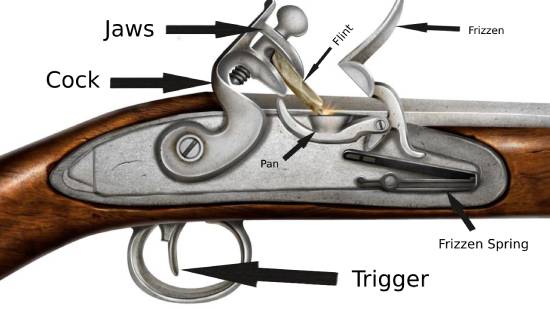Key Point: The matchlock uses a slow-burning match to ignite gunpowder, while the flintlock employs a piece of flint to strike against steel, creating sparks. The matchlock is simpler but has a slower ignition, while the flintlock is more complex but ultimately a lot faster and is thus better in comparison.
Today we will take a look at how the matchlock trigger system compares to the flintlock trigger system. We will cover all the key differences between the two. So, by the time you finish this article, you will know why one was replaced by the other.
Now, as always I will give you the key takeaway of the article first. So, below you can see the main differences between the flintlock and the matchlock:
| Feature | Flintlock | Matchlock |
| Ignition | a piece of flint creating a spark | a slow-burning match |
| Complexity | easier to use | harder to use |
| Speed of use | faster to use | slower to use |
The 3 factors above made the flintlock a superior choice compared to the matchlock. Although the matchlock was better in a certain aspect as you will see in a moment. Now, let’s continue with the …
Ignition System – Matchlock Vs. Flintlock
Now, let’s take a look at the ignition system of a matchlock vs the one from the flintlock. Starting with the matchlock.
The matchlock system used a slow-burning fuse, called a “match,” to ignite the gunpowder. The match was attached to the weapon and hung down in front of the touchhole, the small opening where the gunpowder was placed. When the trigger was pulled, the match that was held by the serpentine, (a curved arm) was lowered to the gunpowder, causing it to ignite the gunpowder in the touchhole and fire the weapon.

This was a bit different when compared to the Flintlock system.
The Flintlock System
The flintlock system on the other hand used a spark created by striking a piece of flint against steel to ignite the gunpowder.

When the trigger was pulled, a mechanism called a “hammer” would strike a piece of flint, creating a spark that fell into the pan, a small reservoir that held the gunpowder.
The pan was covered by the frizzen, a piece of steel that flipped open when the hammer struck it, exposing the pan and allowing the spark to ignite the gunpowder. The flint used in the flintlock system had to be replaced periodically, as it would eventually become too small or worn down to create a spark.
All in all the flintlock had a superior trigger system. Why is that you ask? Well, although the flint had to be replaced from time to time, it was still more reliable than a burning match. Imagine trying to keep that match lit while it was raining. Or, how about when it was windy? The flintlock was more reliable than the matchlock on this basis alone.
Now, let’s move on to …
Matchlock Vs. Flintlock – Their Complexity
The matchlock system was less complex than the flintlock system. Here is why.
It consisted of fewer parts and was easier to produce. This made the matchlock less expensive to manufacture, but it also had some limitations. For example, the match had to be kept burning at all times. That was difficult and dangerous in combat.
Additionally, the match could be easily extinguished in heavy rain or wind, making the matchlock less reliable in certain conditions.
The flintlock system though was more complex than the matchlock.
It consisted of more parts and was more difficult to produce, but it also had several advantages. The flintlock was faster to use, as the user only had to strike the piece of flint against steel to ignite the gunpowder. The flintlock was also more reliable, as the flint would still produce a spark even in wet conditions. The user had to carry and replace the flint periodically, but that was considered a small inconvenience compared to the advantages provided by the flintlock system.
Here the matchlock wins. Although in the end, it did not really matter. This was one of the few cases where armies did not opt for a cheaper weapon over an expensive one.
Speed Of Use
The simple fact is the matchlock system was slower to use compared to the flintlock system. That is one of the main reasons why it lost out at the end to the flintlock. Here is why.
The match had to be kept burning at all times, and when the trigger was pulled, the match was brought into contact with the serpentine to ignite the gunpowder. This process could take a few seconds, and the user had to be careful not to extinguish the match during use.
The flintlock system was a lot faster to use. The user only had to strike the piece of flint against steel to ignite the gunpowder. This process could be completed in a fraction of a second, providing a faster and more reliable ignition system.
Hence, why the flintlock was just so much better than the flintlock.
If You Are Curious: You can see how the matchlock compares to the wheellock trigger system right here. It’s a weird way of firing but it still beat the matchlock (although not in every aspect).
In Conclusion
Thank you for taking the time to read this article. Hopefully, you learned something new. I will see you at the next one.
Take care!
Sources: